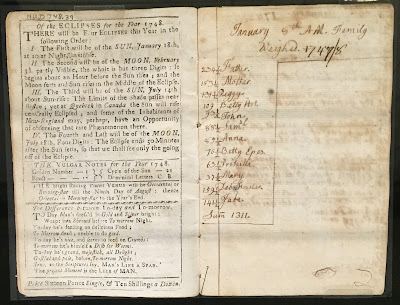Isabella reporting,
Updated January 7, 2016.
The new year is often a time of grim resolutions to undo all the merry-making of the holidays. If the rush of advertisements for weight loss gimmicks and flashy gyms are any indication, there are many Americans who had a sobering confrontation with their bathroom scale on January 1 (or maybe the second.)
But apparently this isn't anything new. In 1748, a young man noted the results of his family's January weigh-in. Born in Marblehead, Massachusetts, John Holyoke (1734-1753) was the son of Edward Holyoke, who became the ninth president of Harvard College in 1737 and moved his family to Cambridge, outside of Boston. Fifteen-year-old John kept an informal diary on the interleaved pages of his copy of An astronomical diary, or, An almanack for the year of our Lord Christ, 1748 by Nathaniel Ames. On these pages, John wrote of the things that interested him: the weather, family illnesses, and his own studies, travels, and daily activities
Opposite a list of the year's eclipses, above, John made his first note for the new year, titled "January 8 AM. Family Weighed 1747/8." (Detail below right; click to enlarge.) In the days before personal scales, weighing oneself meant going to a commercial establishment and using the same scales employed for weighing goods and produce. This wasn't merely a colonial hardship; in faraway London, even dukes presented themselves to be weighed on the commercial scales of Berry Brothers & Rudd. Apparently John's father must have taken his entire extended household to one such set of scales to start the year, and John wrote down the results.
The results are interesting. We modern people tend to think of our counterparts in the past as being much smaller. True, at 93 1/2 lbs, John himself was on the slight side for a young man his age, but his mother weighed 183 1/2 lbs, and his father weighed a substantial 234 1/2 lbs! All those half-pounds must have been important - especially since John totaled everyone's weight for a neat sum of 1316 pounds.
I guessed that Betty Epes, Betty Hol., and Deb Forster are grown cousins, aunts, family friends, or perhaps servants, and it turned out I was right. Thanks to one our "friends of the blog", historian and writer J.L. Bell, I've learned since writing the original post that I was (mostly) guessing right. All were members of the extended Holyoke household; please see his own post here to learn the details of this "blended" family.
But the last name and weight on the list belonged to an individual who most likely lived beneath the same roof, but wasn't considered a true member of the extended Holyoke family. That final entry with a single name belonged to Juba, the family's black slave.
John Holyoke's diary is included in a fascinating exhibition (free and open to the public) currently on display in Harvard University's Pusey Library. Opening New Worlds: The Colonial North American Project features archival and manuscript treasures relating to 17th and 18thc North America, all from the university's libraries and collections. Reflecting every aspect of colonial life, the documents range from diaries and journals to maps, doodles, sermons, and music. The project will digitize the entire collection, and make the documents available for wider study; click here for more information.
Above: Pages from John Holyoke's diary, 1748. Harvard University Archives.
Laws Concerning Women in 1th-Century Georgia
1 year ago


 One of us --
One of us -- 



4 comments:
His parents' clothing is why they are extra heavy.
Anonymous, Yes, the family would have been weighed fully clothed, and in winter clothing at that. But even the many layers of 18thc clothing wouldn't have weighed THAT much. I'm sure the reenactors who follow us & routinely wear 18thc dress can tell us exactly - this is layers of wool and linen with leather shoes, not chainmaille. Mr. Holyoke was still qualify as a fine figure of a man. ;)
When I wear my 18th c. clothing, I am usually wearing only one underpetticoat, but the lining of all of my gowns are made from thick canvas. Including shoes, hats, accessories, etc., which I carry in a single garment bag when traveling, I would estimate everything to be less than 10 pounds. I would add another 5 pounds (generously) for winter attire, in that the fabric would be heavier wool, and that would be including thicker stockings, gloves, and a cloak. This is just my personal experience however.
Thank you for the information, Mariah! Loretta and I have tossed around the idea of writing future posts with the "wearing weights" of 18th and 19thc clothing, and I'll keep your figures in mind. :)
Post a Comment